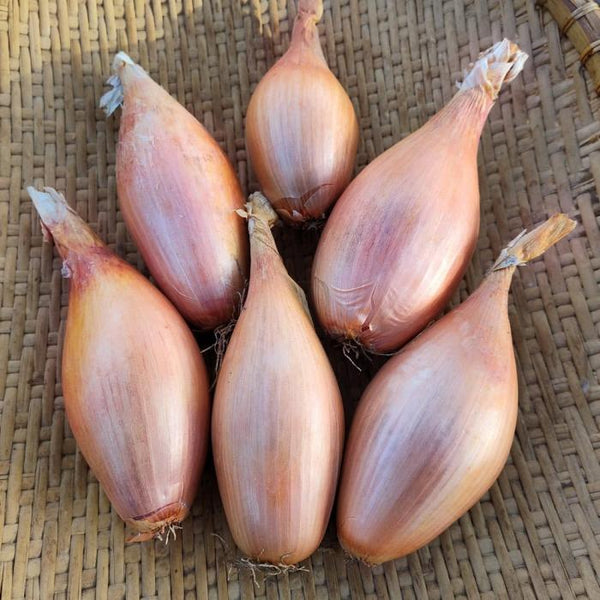Shallot, Zébrune (Cuisse de Poulet du Poitou) (Organically Grown Seeds)
$4.99
This item may be out of season or currently out of stock. Please check back.
Description: Heirloom shallot from France where it is called Cuisse de Poulet du Poitou, which translates as "leg of the chicken"! A type of Eschalion, or banana shallot, so named for its distinctive torpedo shape. Pink-brown bulbs are sweet, mild, and a must for gourmet cooking. Eschalions are said to combine the best qualities of both onions and 'regular' shallots. Bulbs keep well in storage. Productive and resistant to bolting.
Organically Grown/ Heirloom/ Open Pollinated/ Non-GMO
Pack Size: 70 seeds
Latin Name: Allium cepa
Main Uses: Vegetable
Days to Maturity: 100 days to maturity
Exposure: Full sun
Seed Source: Organically grown
Germination: 10 - 21 days, depending on soil temperature. Ideal temperature is 21˙C.
Sowing indoors: 10 - 12 weeks before planting out date. It is preferable to start shallots indoors, as opposed to direct seeding them.
Outdoors: Spring sowing is not recommended in zone 3, due to short season. One option is to plant seeds in late fall, just ahead of snow.
Planting depth: Between 1/8 & 1/4" deep
Spacing: Space transplants 4” - 6” apart
Planting out: Plant in well-drained fertile soil once seedlings are established and serious risk of frost has passed. Shallots require lots of light to grow well, so locate in the sunniest areas of the garden.
Harvesting: Shallots can be picked sparingly through the growing season for their tasty greens (avoiding cutting too much of the central stock). The mature bulbs mature in late summer or early fall; maturity will be evident by withering or browning of the stalks. Harvested bulbs are cured/dried for about 4 weeks to improve storage life.
Growing in Containers: Well - for large raised beds, half barrels and other good sized containers.
Fertilizing (Containers): Plant in a quality, organic- potting mix with good drainage. Shallots require lots of nitrogen for the first half of the growing season, so supplement with a quality organic such as fish-based fertilizer.
Watering (Containers): Water deeply when top inch of soil feels dry to the touch. Check every day or two during very hot weather.
Growing in Mixed Planters: Grows very well in larger mixed planters and raised beds - think square foot gardening!
Fertilizing (Garden): Plant in a garden recently amended with compost. Bi-weekly application of Kelp fertilizer is beneficial. Shallots require lots of nitrogen for the first half of the growing season, so supplement with a quality organic such as Evolve Fish Grow.
Watering (Garden): Water deeply to establish. Water mature plants weekly during hot weather.
Garden Companions:
- Companions plants: Broccoli, Cabbage, Carrots, Lettuce, Strawberries, Tomato, Beets, Tomatoes & Summer Savory.
- Improving the flavour: Plant Shallots/Onions near Cabbage, Beets, Strawberries, Leeks, Lettuce and Chamomile to improve their flavour.
- Avoid: Planting Shallots/Onions near Beans, Peas and Sage as they do not complement each other.
Suitability for Indoors: Not well-suited for indoors.







